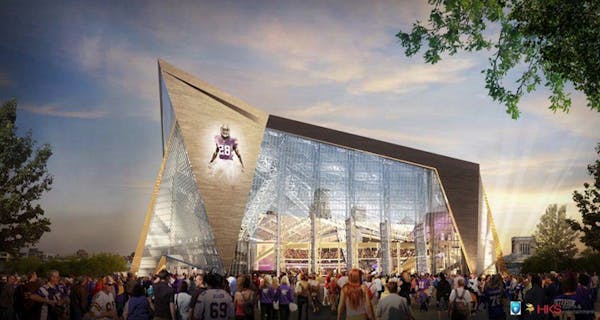When plans were revealed to build a pair of 20-story office towers and a 9-acre park next to the new Vikings stadium, several housing developers wasted no time looking for an opportunity.
"After the announcement, the phone started ringing," said Tom Streitz, director of housing and policy department for the city of Minneapolis.
The $400 million project and the $975 million stadium now in the works have created a buzz that maybe — finally — Downtown East will attract residential development that could help transform the area in a way that the Metrodome never did more than 30 years after its debut.
"This has really ignited some huge interest and the kind of optimism that we haven't had for along time," said Cynthia Froid, a real estate sales agent whose office is just a few blocks from the redevelopment site.
While the enthusiasm may be warranted, spinoff development isn't guaranteed, said Mary Bujold, president of Maxfield Research Group. Interest rates, the economy and jobs growth will dictate what eventually gets built, she said, noting she has received inquiries about residential development, as well. "There are people out there who are simply wondering where they might fit in," she said.
Ryan Cos. announced earlier this month that it plans to build office towers that would accommodate up to 6,000 workers on a five-block area owned by the Star Tribune. A major parking garage will serve the towers' primary tenant, possibly Wells Fargo, and the new Vikings stadium. Ryan has a contract on the land, but it faces several hurdles, including financing, design review and municipal approvals.
Streitz and others say the workers filling those office towers and a public park are far more important than the new stadium for attracting residential development. "Housing will follow jobs," Streitz said. "And Minneapolis is attracting a lot of new employers."
Already, Basant Kharbanda, an investor with multiple land holdings in downtown, says that he has plans to redevelop land he already owns near the new stadium. He envisions building another mixed-used development including offices and housing. Though he's already working on renderings, his effort is contingent upon the final outcome of the Ryan project.
"We plan to work with [Ryan] closely," Kharbanda said. "We want the development to be complementary."
Across Minneapolis, several thousand apartment units are already under construction, most of them in the nearby North Loop, Uptown and University of Minnesota neighborhoods. Developers are hoping to satisfy deep demand for upscale rentals from a growing number of renters by choice who are seeking the excitement and convenience of life in the city.
Until now, most of that development has happened on the fringes of Downtown East — an island of surface parking lots and old office buildings that surround the Metrodome, which is about to host its last season of professional football.
When the Dome opened in 1982, hopes were high that it would help revitalize a section of the city just outside the Central Business District. That never happened, though a handful of offices and warehouse buildings were converted into rental and for-sale housing. The American Trio Lofts, for example, along Park Avenue were carved out of an old warehouse in 2004. And today, an old office building and an adjacent addition will become part of an $18 million apartment building for formerly homeless people and drug addicts that is underway.
In addition, Sherman Associates is fast-tracking its plans to build on a now-vacant corner just a couple blocks from the stadium. Project manager Tony Kuechle said that he expects another condo project to be announced soon.
"When you're talking about 5,000 to 6,000 new people in Downtown East, it's going to drive demand for alternative housing options for those employees," he said.
Long before Ryan announced its plans, the prospect of a new football stadium and the potential for more development, created speculation among many condominium buyers in the area.
At the nearby Sexton Lofts, for example, Kevin Mullen, a sales agent with the Downtown Resource Group, said that even though the project suffered a series of timing and legal problems, he sold 80 condos that had been in foreclosure in the once-troubled condo conversion project within 16 months of marketing them in early 2011.
"The stadium played a big role in the success of the sellout," he said.
Over the past two years, demand for downtown housing has been robust and the supply of condominiums is tight. At the current sales pace, there's less than a three-month supply of condos, according to the Minneapolis Area Association of Realtors, and some buildings don't have a single unit for sale.
So far, there's only one condo building under construction, and it's being developed by Jim Stanton of Shamrock Development. Since construction began earlier this year, more than 60 units of the 164 units at StoneBridge have been presold.
Mullen likens the possibilities for Downtown East to what's happened in the nearby North Loop neighborhood, where Target Field was built in 2010, helping jump-start housing development.
"It's about the lifestyle [and] being able to walk to those kinds of amenities," he said.
Jim Buchta • 612-673-7376 Jennifer Bjorhus contributed to this report
Crop-rich California region may fall under state monitoring to preserve groundwater flow
Microsoft invests $1.5 billion in AI firm G42, overseen by UAE's national security adviser

